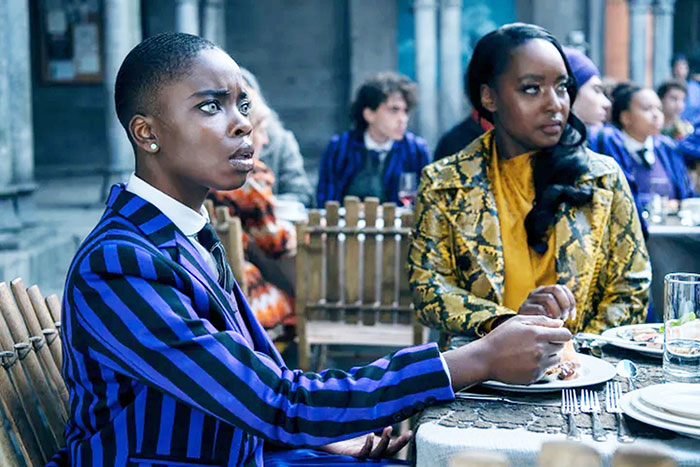
Joy Sunday and Gracy Goldman appear in a scene from Netflix’s “Wednesday.”
By Lindsay Steele
Now Streaming Column
“Wednesday” (MGM Television/Netflix)
Genre: Comedy horror, coming-of-age, supernatural
Streaming service: Netflix
Rating: TV-14 (fear, language, violence, supernatural elements.)

Summary: While attending Nevermore Academy, Wednesday Addams attempts to master her emerging psychic ability, thwart a killing spree and solve the mystery that embroiled her parents 25 years earlier.
Synopsis: Netflix’s “Wednesday,” with Tim Burton as its executive producer, is the latest Addams Family adaptation. The eight-episode series revolves around Gomez and Morticia Addams’ daughter, Wednesday, as she transfers to a private boarding school for supernatural teenagers, Nevermore Academy. Once there, she attempts to solve a murder mystery.
The show is a lot of fun and it’s nice to see a Latino family portrayed positively on screen. About 18% of the U.S. population identifies as Latino, yet they made up only 5.3% of the share of broadcast TV roles in the 2018-19 season, according to the 2020 UCLA “Hollywood Diversity Report.” Jenna Ortega offers a captivating performance as the titular character Wednesday. Luis Guzmán plays her dad, Gomez, and adds a humorous edge to the role.
However, the portrayal of Black characters in the show is a mixed bag. The mayor of Wednesday’s new hometown is Black. While I appreciated seeing a person of color in a leadership role, the mayor’s teenage son is portrayed as a troublemaker. The son redeems himself somewhat at the end, but he is the only Black male teen with a prominent speaking role, which I think unintentionally reinforces an unfair stereotype.
Things aren’t much better at Nevermore Academy, where the teachers and students are overwhelmingly white. The one prominent Black student is portrayed initially as a villain. Additionally, this student and her mother are depicted as “sirens,” with the ability to bend others to their will through seduction. The choice to have Black actresses portraying sirens, as opposed to other supernatural characters — like werewolves, gorgons or vampires — seems insensitive considering the objectification and sexualization of Black women for hundreds of years (blackburncenter.org).
When it comes to portraying racial diversity, not all representation is good representation. People have called out Burton and Netflix on social media for their portrayal of Black characters in this popular series. A representative for Burton called the allegations “silly,” according to a New York Post article.
My observations are not intended to dissuade you from watching and enjoying this and other programs that could do a better job of portraying racial diversity. Change takes time. However, with this being Black History Month, perhaps programs like this one can help stimulate conversations about the portrayal of people of color in video entertainment.
Discussion questions:
Can you think of a character or show that you feel portrayed people of color in a positive light?
Can you think of a character or show that you feel portrayed people of color unfairly?
How has the portrayal of people of color in film and television changed in your lifetime?
(Editor’s note: Lindsay Steele is a reporter for The Catholic Messenger. Contact her at steele@davenportdiocese.org or by phone at (563) 888-4248.)











